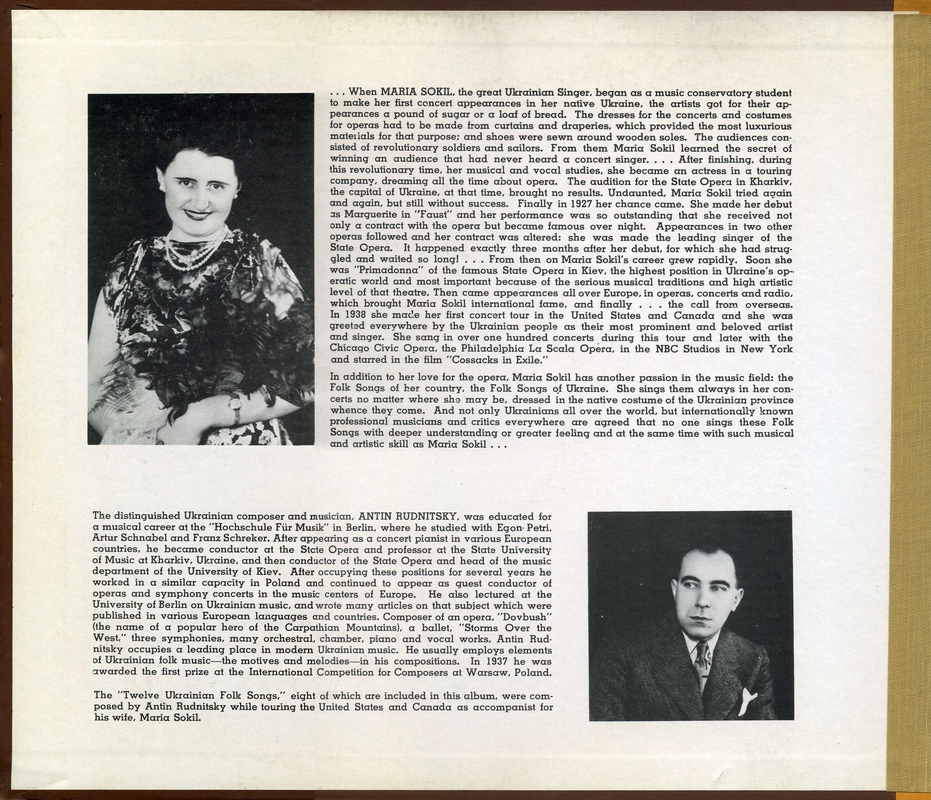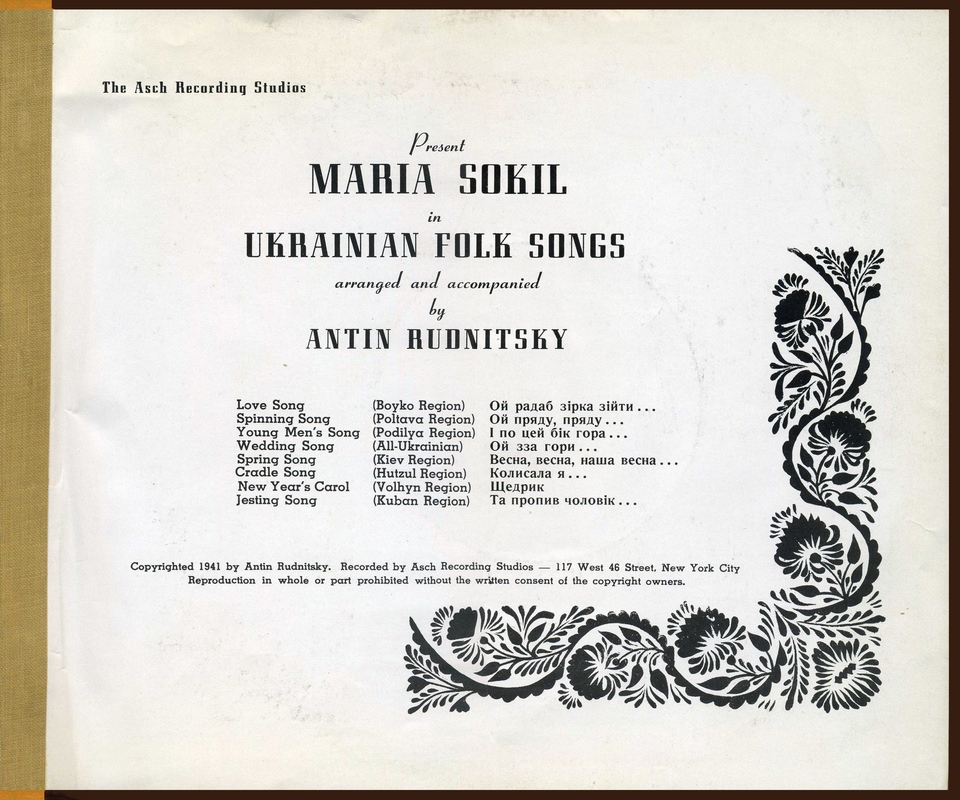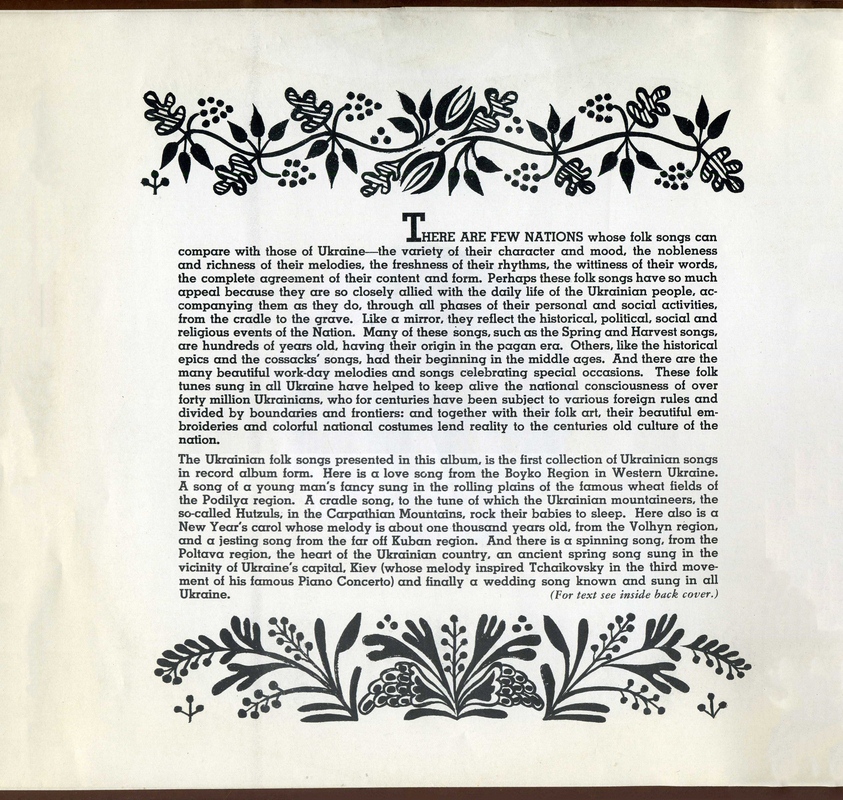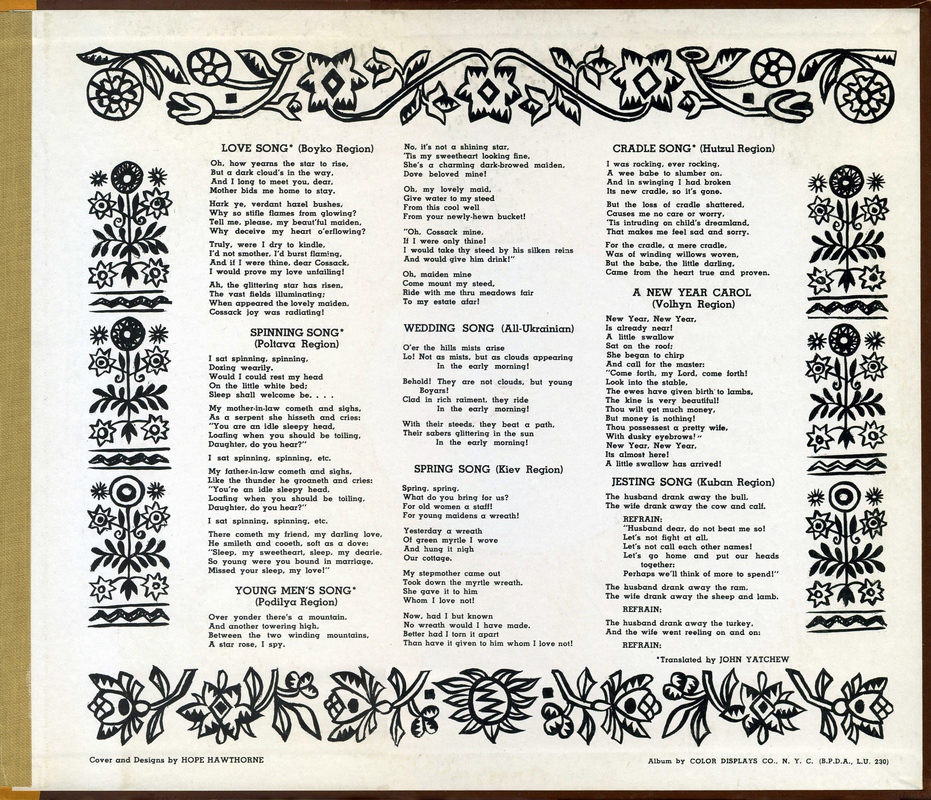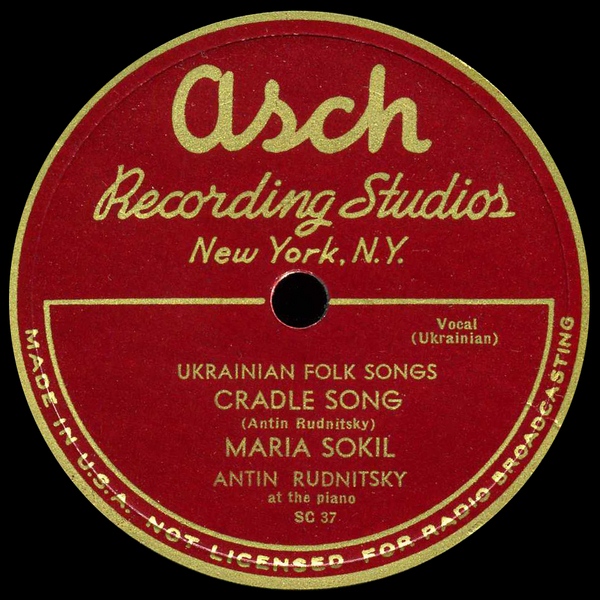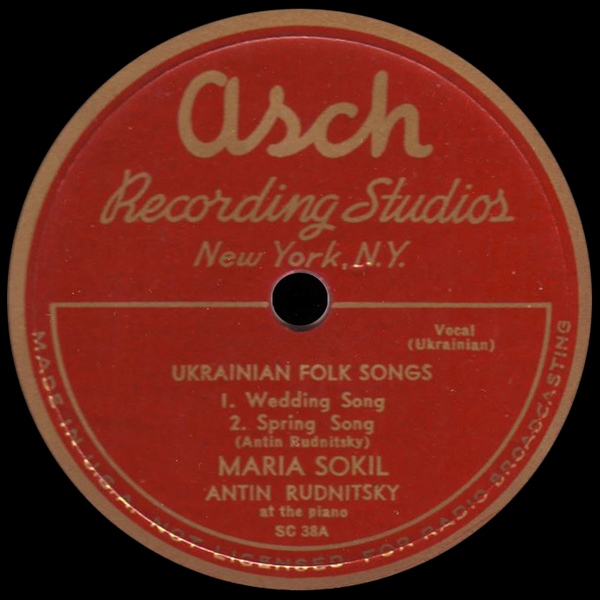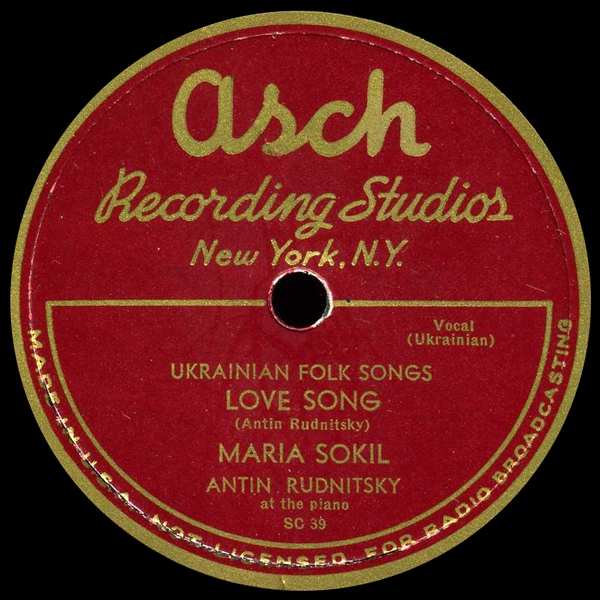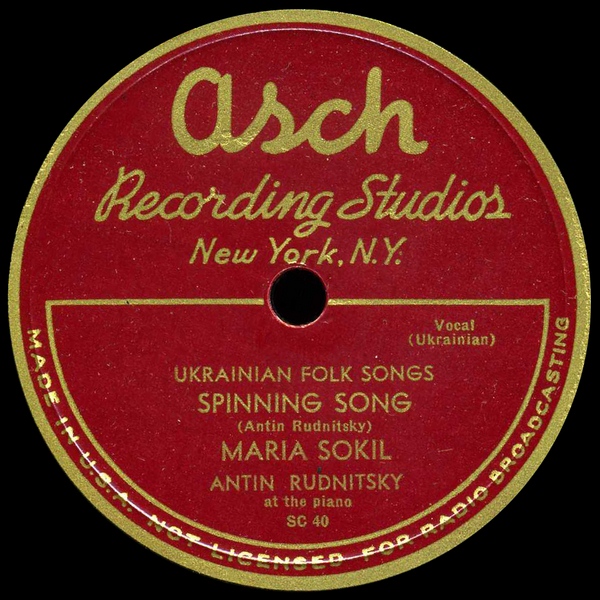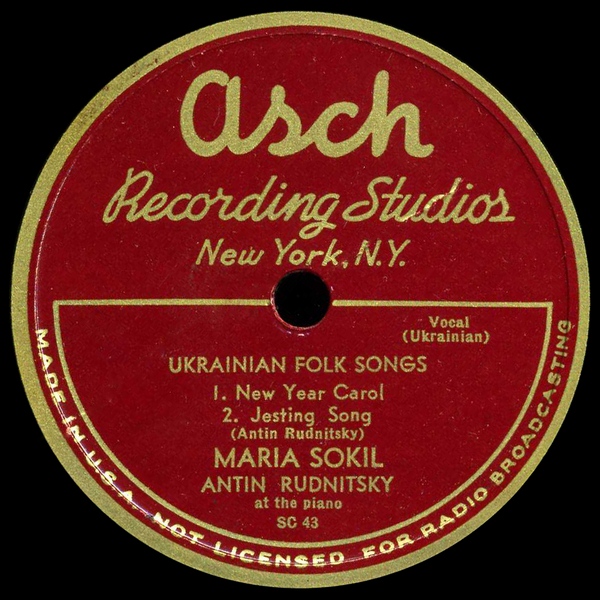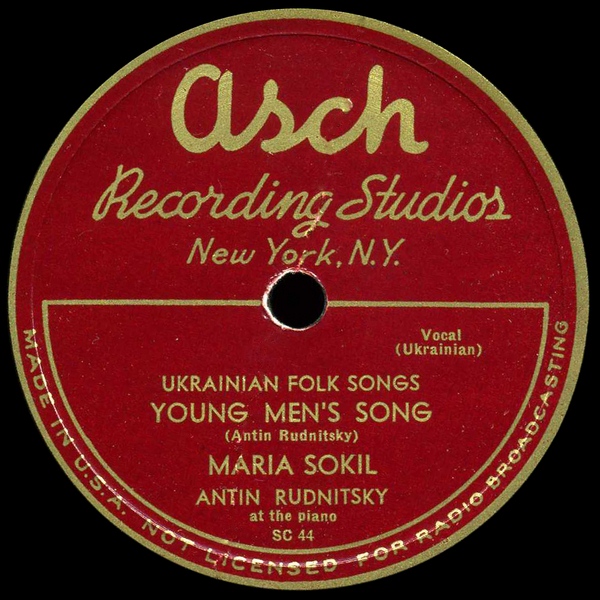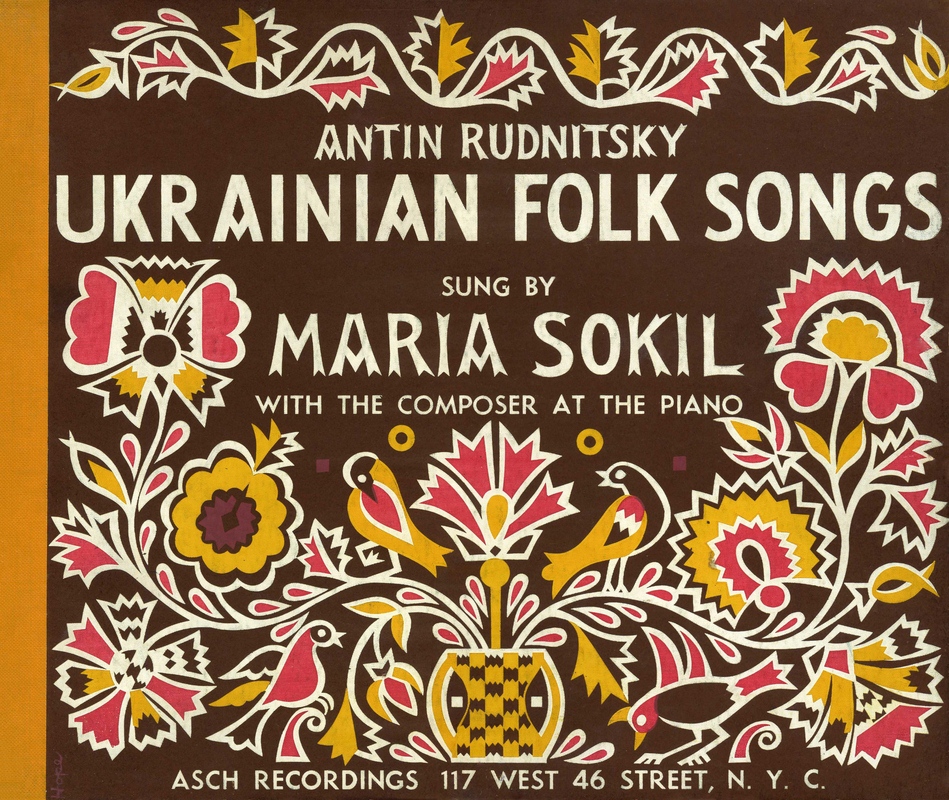
Maria Sokil – Ukrainian folk songs
Виконавець: Maria Sokil / Марія Сокіл
Альбом: Ukrainian folk songs
Видавець: ASCH Recordings SC37 – SC44
Формат: 3 × Shellac, 10″, 78 RPM
Дата видання: 1941
Джерело: колекція ukrmusic.online
| 01 | (SC37) Колисала я / Cradle Song (Hutzul Region) |
| 02 | (SC38) Весна, весна, наша весна / Spring Song (Kiev Region) |
| Ой зза гори / Wedding Song (All-Ukrainian) | |
| 03 | (SC39) Ой рада б зірка зійти / Love Song (Boyko Region) |
| 04 | (SC40) Ой пряду, пряду / Spinning Song (Poltava Region) |
| 05 | (SC43) Щедрик / New Year’s Carol (Volhyn Region) |
| Та пропив чоловік / Jesting Song (Kuban Region) | |
| 06 | (SC44) І по цей бік гора / Young Men’s Song (Podilya Region) |
• arranged and accompanied by ANTIN RUDNITSKY
THERE ARE FEW NATIONS whose folk songs can compare with those of Ukraine – the variety of their character and mood, the nobleness and richness of their melodies, the freshness of their rhythms, the wittiness of their words, the complete agreement of their content and form. Perhaps these folk songs have so much appeal because they are so closely allied with the daily life of the Ukrainian people, accompanying them as they do. through all phases of their personal and social activities, from the cradle to the grave. Like a mirror, they reflect the historical, political, social and religious events of the Nation. Many of these songs, such as the Spring and Harvest songs, are hundreds of years old, having their origin in the pagan era. Others, like the historical epics and the cossacks’ songs, had their beginning in the middle ages. And there are the many beautiful work-day melodies and songs celebrating special occasions. These folk tunes sung in all Ukraine have helped to keep alive the national consciousness of over forty million Ukrainians, who for centuries have been subject to various foreign rules and divided by boundaries and frontiers: and together with their folk art, their beautiful embroideries and colorful national costumes lend reality to the centuries old culture of the nation.
The Ukrainian folk songs presented in this album, is the first collection of Ukrainian songs in record album form. Here is a love song from the Boyko Region in Western Ukraine. A song of a young man’s fancy sung in the rolling plains of the famous wheat fields of the Podilya region. A cradle song, to the tune of which the Ukrainian mountaineers, the so-called Hutzuls, in the Carpathian Mountains, rock their babies to sleep. Here also is a New Year’s carol whose melody is about one thousand years old. from the Volhyn region, and a jesting song from the far off Kuban region. And there is a spinning song, from the Poltava region, the heart of the Ukrainian country, an ancient spring song sung in the vicinity of Ukraine’s capital, Kiev (whose melody inspired Tchaikovsky in the third movement of his famous Piano Concerto) and finally a wedding song known and sung in all Ukraine.
* * *
… When MARIA SOKIL, the great Ukrainian Singer, began as a music conservatory student to make her first concert appearances in her native Ukraine, the artists got for their appearances a pound of sugar or a loaf of bread. The dresses for the concerts and costumes for operas had to be made from curtains and draperies, which provided the most luxurious materials for that purpose; and shoes were sewn around wooden soles. The audiences consisted of revolutionary soldiers and sailors. From them Maria Sokil learned the secret of winning an audience that had never heard a concert singer. . . . After finishing, during this revolutionary time, her musical and vocal studies, she became an actress in a touring company, dreaming all the time about opera. The audition for the State Opera in Kharkiv, the capital of Ukraine, at that time, brought no results. Undaunted, Maria Sokil tried again and again, but still without success. Finally in 1927 her chance came. She made her debut as Marguerite in “Faust” and her performance was so outstanding that she received not only a contract with the opera but became famous over night. Appearances in two other operas followed and her contract was altered: she was made the leading singer of the State Opera. It happened exactly three months after her debut, for which she had struggled and waited so long! . . . From then on Maria Sokil’s career grew rapidly. Soon she was “Primadonna” of the famous State Opera in Kiev, the highest position in Ukraine’s operatic world and most important because of the serious musical traditions and high artistic level of that theatre. Then came appearances all over Europe, in operas, concerts and radio, which brought Maria Sokil international fame, and finally . . . the call from overseas. In 1938 she made her first concert tour in the United States and Canada and she was greeted everywhere by the Ukrainian people as their most prominent and beloved artist and singer. She sang in over one hundred concerts during this tour and later with the Chicago Civic Opera, the Philadelphia La Scala Opera, in the NBC Studios in New York and starred in the film “Cossacks in Exile.”
In addition to her love for the opera, Maria Sokil has another passion in the music field: the Folk Songs of her country, the Folk Songs of Ukraine. She sings them always in her concerts no matter where sho may be, dressed in the native costume of the Ukrainian province whence they come. And not only Ukrainians all over the world, but inf emotionally known professional musicians and critics everywhere are agreed that no one sings these Folk Songs with deeper understanding or greater feeling and at the same time with such musical and artistic skill as Maria Sokil …
* * *
The distinguished Ukrainian composer and musician, ANTIN RUDNITSKY, was educated for a musical career at the “Hochschule Für Musik” in Berlin, where he studied with Egon-Petri, Artur Schnabel and Franz Schreker. After appearing as a concert pianist in various European countries, he became conductor at the State Opera and professor at the State University of Music at Kharkiv, Ukraine, and then conductor of the State Opera and head of the music department of the University of Kiev. After occupying these positions for several years he worked in a similar capacity in Poland and continued to appear as guest conductor of operas and symphony concerts in the music centers of Europe. He also lectured at the University of Berlin on Ukrainian music, and wrote many articles on that subject which were published in various European languages and countries. Composer of an opera, “Dovbush” (the name of a popular hero of the Carpathian Mountains), a ballet, “Storms Over the West” three symphonies, many orchestral, chamber, piano and vocal works, Antin Rudnitsky occupies a leading place in modern Ukrainian music. He usually employs elements of Ukrainian folk music – the motives and melodies – in his compositions. In 1937 he was awarded the first prize at the International Competition for Composers at Warsaw, Poland.
The “Twelve Ukrainian Folk Songs,” eight of which are included in this album, were composed by Antin Rudnitsky while touring the United States and Canada as accompanist for his wife, Maria Sokil.
Copyrighted 1941 by Antin Rudnitsky. Recorded by Asch Recording Studios — 117 West 46 Street, New York City
Reproduction in whole or part prohibited without the written consent of the copyright owners.
Cover and Designs by HOPE HAWTHORNE
Album by COLOR DISPLAYS CO., N. Y. C. (B.P.D.A., L.U. 230)
